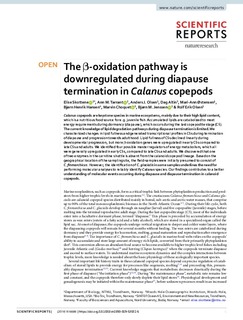The β-oxidation pathway is downregulated during diapause termination in Calanus copepods
Skottene, Elise; Tarrant, Ann M.; Olsen, Anders Johny; Altin, Dag; Østensen, Mari-Ann; Hansen, Bjørn Henrik; Choquet, Marvin; Jenssen, Bjørn Munro; Olsen, Rolf Erik
Journal article, Peer reviewed
Published version
Permanent lenke
http://hdl.handle.net/11250/2636348Utgivelsesdato
2019Metadata
Vis full innførselSamlinger
- Articles [3012]
- Publikasjoner fra CRIStin [3070]
Originalversjon
10.1038/s41598-019-53032-5Sammendrag
Calanus copepods are keystone species in marine ecosystems, mainly due to their high lipid content, which is a nutritious food source for e.g. juvenile fish. Accumulated lipids are catabolized to meet energy requirements during dormancy (diapause), which occurs during the last copepodite stage (C5). The current knowledge of lipid degradation pathways during diapause termination is limited. We characterized changes in lipid fullness and generated transcriptional profiles in C5s during termination of diapause and progression towards adulthood. Lipid fullness of C5s declined linearly during developmental progression, but more β-oxidation genes were upregulated in early C5s compared to late C5s and adults. We identified four possible master regulators of energy metabolism, which all were generally upregulated in early C5s, compared to late C5s and adults. We discovered that one of two enzymes in the carnitine shuttle is absent from the calanoid copepod lineage. Based on the geographical location of the sampling site, the field-samples were initially presumed to consist of C. finmarchicus. However, the identification of C. glacialis in some samples underlines the need for performing molecular analyses to reliably identify Calanus species. Our findings contributes to a better understanding of molecular events occurring during diapause and diapause termination in calanoid copepods.
